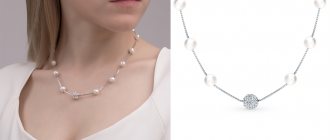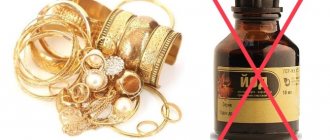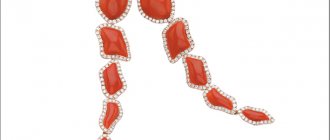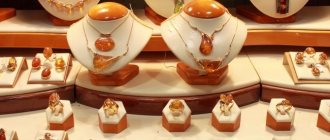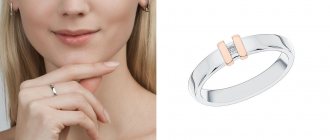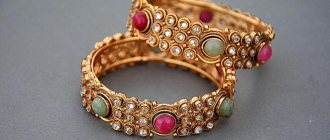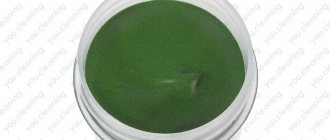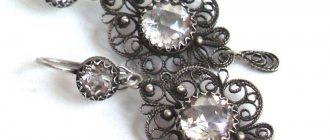Pearls come from mollusk shells, so they should be treated with great care. Jewelry with mother-of-pearl looks elegant and stylish, but alas, such jewelry lasts only 100–150 years, so you need to know exactly how to clean pearls at home in order to increase their lifespan.
How to clean pearl beads at home
One cannot help but admire natural pearls: the tears of the sea, born from mother-of-pearl pearl mussels, will never go out of style. Despite the appearance of many imitations, from cheap to very worthy, natural pearls are constantly enjoying resounding success. And large sea pearls rightfully belong to the category of precious stones.
The modern trend for pearl necklaces owes its origin to the legendary Coco Chanel. The combination of a little black dress, pumps with elegant heels and a string of natural pearls is a win-win option for any special occasion.
One thing is bad: natural sea and river pearls are very delicate and capricious. It cannot stand direct sunlight or temperature changes, and aggressive chemicals simply kill it. You can clean pearl beads using special compounds that are sold in jewelry stores, but if you wish, you can also use gentle means at hand.
So, to clean pearl beads at home, you can use:
- Soapy solution. Add a few drops of liquid soap without dye to a glass of clean cold water and leave the decoration in there for literally an hour. Then we remove the jewelry and remove dirt using a cotton pad or soft cloth.
- Salt. You cannot rub pearls with salt: it is too aggressive an abrasive for them. So just sprinkle table or sea salt on a cotton cloth or gauze folded in several layers, put the decoration there and tie it in a knot. Place this knot under a stream of cold tap water. The salt should completely dissolve and wash out, cleaning the pearls.
- Olive oil or starch. We wet a sponge or soft cloth in oil and rub the jewelry without excessive zeal. Starch can be used in the same way. These manipulations will be more effective if you first soak the jewelry in a soapy solution and then dry it.
Don't try to replace olive oil with cheaper options. For example, sunflower or rapeseed oil will make pearls greasy, leaving stains on clothes.
What is prohibited in cleaning pearls?
When manipulating a gem, the following are contraindicated:
- hot water, steam;
- window and dishwashing detergents;
- nail polish remover, other solvents;
- soda, alkaline cleaners;
- vinegar, other acids;
- alcohol, including ammonia;
- abrasive powders;
- ultrasound;
- It is prohibited to use brushes or synthetic sponges.
They will cause pearls to become dull, scratched, or lose their nacreous layer.
How to clean natural stone beads?
Natural stones are minerals of inorganic origin! These do not include ivory, amber, coral, the aforementioned pearls, etc. The attitude towards organic matter should be special, stemming from the type of specific material.
You can clean beads made of natural stone (not organic!) in a soap solution, and you can make it much more concentrated, and extend the soaking even overnight. After this, you can remove dirt with a soft toothbrush.
Silver necklace with garnet (go to SUNLIGHT catalogue)
And if you want the stones to gain shine and transparency, you can use a solution of ammonia (40-50 drops of ammonia in half a glass of water). You need to immerse the jewelry in the solution for literally half an hour, remove any dirt, then rinse thoroughly and dry with a soft cloth or hairdryer (not with hot air).
All processes associated with ammonia are accompanied by an intense ammonia odor. So either move them to the balcony or leave the soaking solution under a tight lid. And wear gloves!
How to clean framed items
Processing pearl jewelry with metal is more troublesome. After all, you need to properly clean both the frame and the gem, and with different means.
The composition used to clean metal jewelry should not come into contact with pearls. If this happens, the bead is quickly washed with water.
Dirt from the relief of jewelry and the gaps between the insert and the metal is removed with a wooden toothpick.
Gold
To clean gold-framed jewelry, choose one of the following methods:
- moisten a stick with cotton wool with ammonia and gently wipe the metal;
- Cosmetic powder (baby powder, chalk powder) is poured onto the flannel and the metal is polished.
Pearl inserts can be cleaned with soapy water. The decoration is rinsed twice and left to dry.
The noble metal gets dirty quickly, so experts advise refreshing gold accessories every two to three weeks.
Silver
Silver products are “renewed” four to six times a year. The procedure is as follows:
- extinguish soda with vinegar or ammonia;
- Lubricate the metal with the mixture.
While the silver is “soaking,” wipe the pearls with a cloth moistened with soapy water.
After half an hour, rinse twice with warm water and wipe the product well.
Caring for plastic beads
Plastic beads, no matter how elegant they are initially, “age” much faster than their jewelry counterparts. This is especially noticeable with cheap jewelry that is painted only on the surface: if the paint layer comes off, there is nothing you can do to help the jewelry. And you can’t wear it: nothing spoils a bow more than old, shabby jewelry.
But this does not mean that there is no need to clean plastic beads: natural body secretions and other contaminants also accumulate on them. The best option is soaking in a soapy solution, followed by gentle removal of dirt using a sponge, rinsing and drying.
Daily care rules
Jewelry with pearls is not intended for daily wear, since changes in temperature and humidity levels damage the stone. Also, the gem deteriorates under the influence of human sweat, sebum and dust. Therefore, jewelry should only be worn on a clean body. Do not spray perfumes or compositions containing essential oils on jewelry. Jewelry must be removed before visiting the pool, playing sports, or swimming in the river.
After wearing, the gem should be wiped with a damp cloth each time, which will help remove greasy deposits and dust. It will also restore the rich color of pearls. To store products with sea stone, you need to allocate a separate box. It is recommended to wrap each decoration with velor flaps. Products with high hardness stones (diamonds, emerald, crystal, quartz) should not be stored together with pearls.
Important! It is necessary to protect jewelry from direct sunlight, high levels of humidity and heat. It is not recommended to wear jewelry together with woolen and synthetic clothing, as its threads can damage the mother-of-pearl layer. When putting on (taking off) beads, hold the item by the lock, not by the beads.
If you wear beads, you need to regularly replace the thread with a new one. It is better to entrust this work to a professional.
How to straighten fishing line on a necklace
Another common problem is deformation of the string of a necklace or beads. Try to avoid this, because almost always the root of this problem is improper storage, transportation or wearing of jewelry.
Gold necklace with cubic zirconia (go to the SUNLIGHT catalogue)
Straightening beads on a fishing line is quite difficult, because you need to act extremely carefully so as not to damage the decorative elements. The most gentle way is to hang the necklace in a warm place (for example, near a radiator) and lightly weigh it down with a weight so that the fishing line straightens.
You can also straighten the fishing line on an invisibility necklace using steam from a steamer or an iron with the appropriate option. But you need to apply steam carefully, only to the problem area and in no case to the pebble!
Special silicone fishing lines are used in the production of jewelry. Sometimes their deformation is irreparable, and the base has to be changed, which is difficult to do without the proper skills.
Home Remedies for Cleaning Silver
Foam bath . Dissolve a teaspoon of liquid soap (shampoo) in a glass of warm water. Place the jewelry in the solution for an hour. Carved and openwork parts can be additionally rubbed with a soft brush or cotton swab. After taking a foam bath, rinse the jewelry thoroughly with running water and dry with flannel or velvet cloth.
Salt + water . Place the pearl jewelry on a white linen or cotton napkin and sprinkle thickly with salt. Tie the ends of the fabric together to make a tight pouch. Rinse it in water until the salt dissolves. Contact with salt particles cleanses the silver and acquires shine, and the delicate shimmer returns to the pearl, because it is a sea mineral and loves salt.
Silver jewelry parts can be cleaned:
- a slurry of soda, chalk or potato starch;
- an ordinary stationery eraser;
- toothpaste;
- ammonia (5 drops per 200 ml).
But such procedures are contraindicated for pearls - during friction, fine abrasive particles will damage the mother-of-pearl surface of the beads, and alcohol turns the pearls yellow.
How to store beads?
Beads should be stored at home in a special box, not mixed together, but in individual compartments. The box should be placed in a dry place with neutral room temperature and protected from dampness.
In addition, it is permissible to store beads and jewelry on special hangers or jewelry trees. However, this method is best used as a temporary measure: the bases of the beads can stretch and deform, and the beads can accumulate dust and suffer from direct sunlight.
And don’t forget that jewelry needs to be walked: if you don’t give it proper attention, it can fade. However, just like the most beautiful woman loses some of her shine without her favorite necklaces, beads and chokers!
24.05.21
What are pearls?
Natural pearls are a solid substance consisting of mother-of-pearl. It is formed in the shells of mollusks - in the so-called pearl oysters. Pearls are mined in the natural environment or in artificially created conditions.
Depending on the place of extraction, it happens:
- nautical;
- freshwater (river).
Pearls are widely used in the manufacture of jewelry: rings, earrings, bracelets, beads, brooches and many others. The stones are set in silver, gold, platinum, and in all cases they look very dignified and presentable. The final cost of the item is usually determined by the origin, color, size and shape of the stone, as well as the metal in which the pearl was set.
Black pearls are one of the rarest and most unique species found in nature.
Recently, you can often see on sale artificial material that is created from glass and then painted in the desired color. Over time, the beads lose a significant part of the dye and look unaesthetic. Of course, in terms of their properties, these “pearls” have nothing in common with real jewelry.
Let's talk in more detail about how to properly care for pearls.
In one pearl oyster you can find from one to several pearls
Storage rules
In order for pearl products to retain their attractive appearance for as long as possible, the following rules must be observed when using them:
- Store in a delicate fabric bag separately from other accessories or in an individual box. Before storing the product, it is recommended to wrap it in a piece of velor or suede.
- Keep away from direct sunlight. Due to prolonged exposure to the scorching sun, the stone can not only lose its shine, but also become cloudy.
- Do not expose to low or high temperatures. Too dry air can cause cracking of the surface of the beads, and humid air can cause clouding. For this reason, it is not recommended to allow pearl beads or earrings to come into contact with wet skin. If the room where the pearl jewelry is stored is dry, it is recommended to place a container of water next to the jewelry box.
- Do not allow pearl accessories to come into contact with dirty skin. The stone quickly absorbs oil secreted by the skin and dirt.
- Avoid getting hairspray, eau de toilette, and cosmetics on the beads.
- Remove pearl jewelry by holding it by the clasp or lock, but not by the beads.
- After each use, wipe gently with a delicate, lint-free cloth.
- After cleaning, dry flat on a soft cloth in cool, dark conditions. Otherwise, the thread on which the pearl beads are strung will stretch.
- The thread should be changed every 2-3 years. If you use an accessory with pearls every day, it is recommended to do this annually.
- Separate the beads from each other with knots. This measure eliminates friction and damage.
- Do not wear pearl jewelry with woolen items at the same time.
When purchasing pearl jewelry, you need to take care of the place in which it will be placed. It is required to keep the products in a room where there are no temperature changes. Sufficient room humidity will create favorable conditions for storage. If there is a lack of moisture, microcracks form on the beads. In a room with high humidity, pearls may become cloudy. If there is low humidity in the room, then you need to place a glass of water in the place where the products are stored.
Pearl jewelry is stored in a special box, which is covered with velvet. This is necessary to prevent the penetration of bright rays of the sun, which lead to loss of shine of pearls. It is better not to store other jewelry next to pearls.
As experience accumulated over centuries shows, pearl jewelry should be worn regularly. Exposure of pearls to human sweat, which has a mildly acidic environment, promotes the dissolution of its damaged surface layers; it remains “alive,” retaining its luster and original color for a long time.
When storing jewelry with pearls for a long time, you need to create comfortable conditions for them:
- a dark place (it is better to store it in a special box or casket), but they cannot be closed too tightly; there must be free access to fresh air;
- Before sending pearls for long-term storage, they must be thoroughly washed with a soapy water solution to remove dust and other surface deposits;
- store each item separately, wrapped in a soft velor or suede napkin, avoid contact of pearls with any hard objects; the clasp of a necklace, for example, can leave scratches;
- To ensure that the place where pearl jewelry is stored does not become excessively dry, you can place an open vessel with water nearby (the main thing is that it does not accidentally tip over), or lightly sprinkle a napkin with water;
- exclude their storage near household detergents and cleaners, various kinds of solvents, paints and varnishes, the fumes of which can affect the structure of the pearls;
- Periodically check the condition of pearl jewelry and, if necessary, clean them.
For pearls, the storage location and climatic parameters of the room are important.
Pearls are delicate and need to be stored in a special box:
- Strength. A casket or box of rigid construction is suitable. Fabric bags and plastic bags are not suitable: the beads will rub against each other or the metal parts of the frame.
- Softness. For interior upholstery, choose soft fabric: silk, satin, velvet, suede, flannel.
- Dimensions. The box is spacious so that the decorations are arranged in one layer.
- Tightness. The box should close completely, but not tightly. Pearls are protected from light, dust, and access to air and moisture is maintained.
The presence of other minerals in the pearl box is excluded.
Climate control
Pearls need appropriate “weather in the house.” Conditioner is ideal; If this is not possible, take into account the storage conditions of the products:
- Temperature and humidity are average. In a cold or damp room the stones will become cloudy. If it is very hot, it will crack if it is dry. Sudden temperature changes are unacceptable.
- Dust. Creates microcracks on beads.
- Light. Stones worn for a long time on the beach or on a summer walk become dull and yellow.
- Smoke. Pearls that have become yellowed or tarnished by tobacco smoke cannot be restored.
Home Remedies for Cleaning Silver
Foam bath . Dissolve a teaspoon of liquid soap (shampoo) in a glass of warm water. Place the jewelry in the solution for an hour. Carved and openwork parts can be additionally rubbed with a soft brush or cotton swab. After taking a foam bath, rinse the jewelry thoroughly with running water and dry with flannel or velvet cloth.
Salt + water . Place the pearl jewelry on a white linen or cotton napkin and sprinkle thickly with salt. Tie the ends of the fabric together to make a tight pouch. Rinse it in water until the salt dissolves. Contact with salt particles cleanses the silver and acquires shine, and the delicate shimmer returns to the pearl, because it is a sea mineral and loves salt.
Silver jewelry parts can be cleaned:
- a slurry of soda, chalk or potato starch;
- an ordinary stationery eraser;
- toothpaste;
- ammonia (5 drops per 200 ml).
But such procedures are contraindicated for pearls - during friction, fine abrasive particles will damage the mother-of-pearl surface of the beads, and alcohol turns the pearls yellow.
How to restore shine
Tarnished cultured or natural pearls can be revived in several ways:
- Sun. “Bath” under non-aggressive rays for two to three hours. Several sessions are acceptable, but the pearls should not become hot. After a sunbath, they are wrapped in a soft cloth.
- Water. The decoration is immersed for an hour or two in warm water with sea salt (from a pharmacy or supermarket). The water can be tap water: salt neutralizes chlorine.
- Vegetable oil. Peeled olive oil is suitable. Apply to cotton wool, which is used to wipe the beads. The remains are blotted with a paper napkin.
- Special paste to restore shine. It is not used often because it wears away the mother of pearl.
- Regular rubbing with a piece of velvet.
All methods are applicable to material cleared of contaminants.
Cleaning pearls
Third life hack: Clean silver with toothpaste
Another cleaning product that is available in any bathroom and in any travel bag is a tube of toothpaste, preferably without fragrances or dyes.
Apply toothpaste to a soft sponge or cloth or toothbrush and methodically wipe the darkened ring or chain with it over and over again. Then we rinse the silver thing, especially carefully washing the paste from hard-to-reach places, and you’re done!
Your favorite silver sparkles like the white teeth from a Colgate commercial or the Forest Balsam you know from childhood.
You can clean silver with a makeshift paste of water and tooth powder, which is still sold in pharmacies. But, as in the case of soda, you should not use it to clean things with rhinestones, pearls and precious stones.
Cleaning earrings with organic inserts
Natural elements combined with silver look great and are suitable anytime, anywhere. But cleaning earrings with organic inserts requires a delicate approach.
Natural elements can be shells, ivory, petals sealed in resin, stones (amber, coral, mother-of-pearl), wood, etc. It is best not to wet such jewelry, or gently wipe the silver part with soapy water or use a school eraser, and the organic insert treat with a soft cloth. It is strictly forbidden to use acids, alcohol, ammonia, soda, etc., on such jewelry.
Method two: Clean silver with ammonia
This life hack was also used by our grandmothers, who were not spoiled by the abundance of cleaning products in multi-colored plastic jars.
This method is homemade and cheap, quick and simple: add a few drops of ammonia to warm water, as when washing windows, put a silver chain or ring in there for 30-40 minutes, take it out, rinse and wear it for health.
This technique allows you to safely clean even items decorated with precious stones. But it is not suitable for allergy sufferers and citizens with a particularly sensitive sense of smell who cannot stand the smell of ammonia.
Life hack number four: Clean silver with citric acid or lemon juice
You can also remove dark deposits from silver using a “bath” with citric acid or lemon juice.
This is done like this: we prepare a solution (at the rate of 200 grams of citric acid per liter of water or 5-6 drops of juice), lower the silver product into it, place it on the burner, bring the solution to a boil, turn off the burner and leave the silver to “soak” while the water won't cool down.
Take it out, rinse, wipe and polish with a clean soft cloth and wear it quietly!
This method is suitable for inexpensive silver items and is completely unacceptable for jewelry with stones, rhinestones, enamel or niello.
Attention: Careful dosage is required here: the slightest inattention will ruin the entire product.
Cleaning Features
Pearls are very demanding in terms of storage and care conditions. It is negatively affected by the following factors:
- Direct sunlight will discolor the jewelry and make it dull.
- The material contains about 2% water, so the humidity of the surrounding air affects its condition. Excess moisture leads to fading, and too dry air leads to cracking.
- Exposure to human sweat causes loss of shine.
- Acids, which are included in most cosmetic products, corrode the surface nacre.
Therefore, a good habit to keep your favorite jewelry in its original form would be to clean your rings, bracelets, earrings or necklaces after every appearance.
What products should not be used
Caring for pearls on your own can cause damage to your jewelry if you use cleaning products with the wrong composition. The greatest danger to the integrity of the surface layer of pearl products is:
- brushes or hard sponges;
- hot water;
- vegetable oils (except for highly refined natural olive oil);
- abrasives;
- solvents and alkalis;
- dishwashing detergents;
- popular cleaning agents such as ammonia, hydrogen peroxide, vinegar;
- baking soda;
- ultrasonic cleaning.
